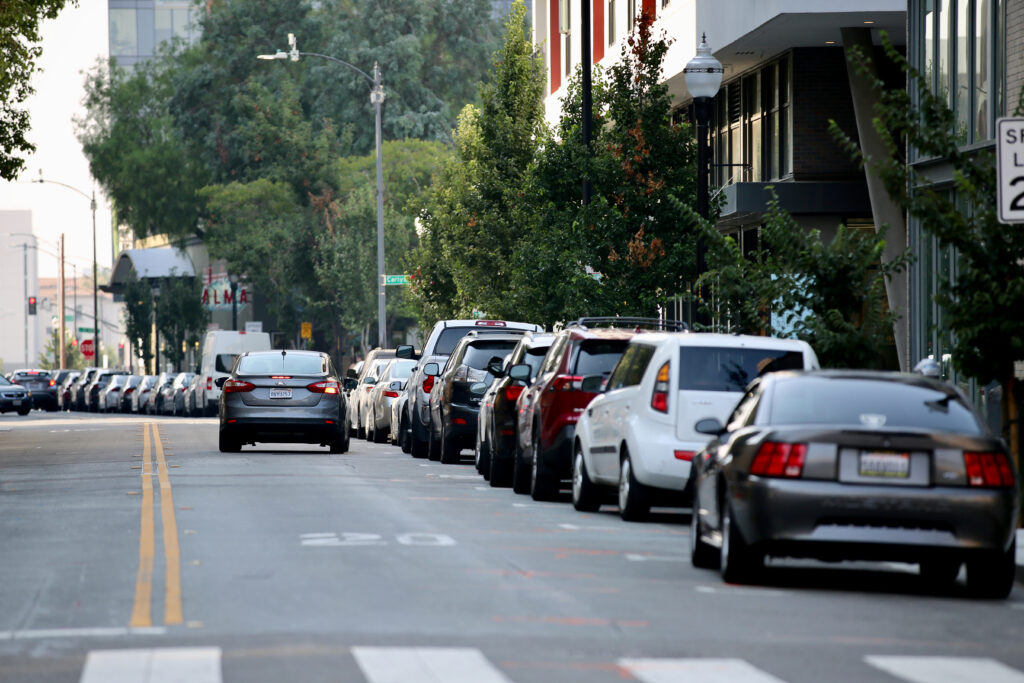While San Jose and the rest of society still hasn’t achieved the flying car future depicted in “The Jetsons,” city officials are hoping to make more efficient, safe and sustainable streets by studying how curb space is used.
San Jose is receiving about $2 million in federal funding to address how to best use limited curb space in downtown, where a growing number of people and services compete for room.
The long-term goals are to ensure more people and businesses can easily access curb space as needed, while increasing safety by cutting traffic congestion, gridlock and conflicts for space, officials said.
The city plans to eventually share real-time curb parking space availability online, similar to what it already does for its parking garages.
“With more delivery services out there in addition to our traditional UPS, FedEx and USPS—you’ve got Instacart, Amazon and Uber Eats—there is more demand on curb space. Plus ride hailing, that adds to it as well,” Colin Heyne, a spokesperson for the city’s Department of Transportation, told San José Spotlight.


Heyne said the city tracks plenty of information about its streets already, but officials need to learn more curb space to plan for possible changes in use.
“We don’t have a running inventory of how many miles there are of curb and how many of those miles are used, for example, for 20-minute parking. Or how many miles are curb space restricted because they are in front of a fire hydrant,” Heyne said. “Nitty gritty measurements about the curbs, we do not have that currently.”
San Jose is also looking to use sensor technology to track how curb space is being occupied, whether it be a patron of a business, a delivery vehicle or rideshare car.
The work, spread out over the current and coming fiscal year, will be largely funded by a grant from The Infrastructure Investment and Jobs Act, also known as the Bipartisan Infrastructure Law. The city will kick in about $707,000 of in-kind staff time to manage the projects.
The city will use a protocol for tracking curb information called “curb data specification,” developed by a consortium of transportation experts across several U.S. cities called the Open Mobility Foundation.
Adam Cohen, a researcher at San Jose State University’s Mineta Transportation Institute, said using curb data specification will help the city optimize how curbs are used throughout the day and week, and easily transfer that information to people digitally.
“The city of San Jose down the road can say, ‘You know what, based on demand for the curb, we think that this particular part of the curb should be a transit lane during peak hours. It should be outdoor dining during lunch hour, bike and scooter share parking during midday, and it should be a late-night loading zone for Uber and Lyft for evening activities such as bars and restaurants and clubs,’” Cohen told San José Spotlight.
While curb signs have been used for decades and can include multiple restrictions for different days and times of the week, signs don’t respond to actual use on a moment to moment basis.
Cohen said dynamic curb management could allow the city to better adjust curb restrictions to accommodate more rideshare pickups in certain areas, like after a Sharks game or near downtown on weekends, and to be able to quickly block curbs for special events or road work. The inventory of curb space, along with lampposts, trash cans, outdated curb ramps and sidewalks, will help the city map out hazards and plan for improvements to make the area more accessible to people of all abilities.
District 3 Councilmember Omar Torres, who represents downtown, said the plans fit into the city’s goals for downtown and the city overall.
“The city of San Jose is for everyone and these curbs are meant for everyone, especially folks with disabilities,” Torres told San José Spotlight. “We want walkable, beautiful neighborhoods and business districts.”
Cohen said the hope for such technological upgrades is that the city, and others like it that San Jose is collaborating with on the issues, will be able to adapt to future needs of curb users as the city shifts and grows.
“The curb is a very dynamic and constantly evolving space, the modes are constantly changing and how people use the curbs constantly changes,” Cohen said. “So anything that can help add flexibility and help manage those changes going forward is generally a good thing.”
Contact Joseph Geha at [email protected] or @josephgeha16 on Twitter.



Leave a Reply
You must be logged in to post a comment.